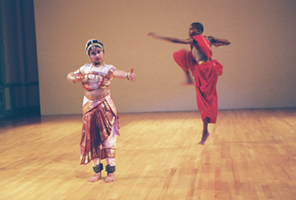SITA SPEAKS grew out of an abstract concept – to compare American Sign Language and the hand gesture language called mudra, which is used in Indian classical dance. The choreographer chose the text from India’s epic RAMAYANA in response to photographs of America’s war in Iraq in the media in October and November 2003. The photographs, which drove the creation of this brief dance theater piece, showed the price of human suffering paid by those who wage war and those who endure its consequences.
As this dance developed, it also grew into an examination of language and human emotion, and their translation into gesture. Sanskrit, Kenya’s Kikuyu language, English, American Sign Language, abstract emotive gesture and mudra all illuminate the words which the epic’s female heroine Sita speaks.

Considered by modern-day Hindus as the divine paradigm of a faithful and obedient wife, this Sita says to her warrior husband, “My mighty husband, I do not like your going to Dandaka forest…On no account should you take up your bow and, unprovoked, turn your thoughts to killing the demons of Dandaka. My mighty husband, I do not like your killing creatures that have done no wrong. Wicked thoughts come from handling weapons.”
The words which Sita speaks this evening to her husband Rama have been excerpted from the original version of the RAMAYANA. Composed in Sanskrit by Valmiki (500 B.C.E. ?), the RAMAYANA was preserved orally for at least a millennium before being committed to written form. In its original version the hero Rama and heroine Sita move through a landscape of court life and elemental natural forces. Banished to the forest as a result of court intrigue, Rama decides to wait out his seven-year absence from society by fighting demons in the wildest reaches of the forest. Rama and Sita’s departure from and return to civilization involves a transformative journey.
An archetypal story of love, lust, war, and transfer of power from king to eldest son, the RAMAYANA forms the core repertoire of many South Asian theater and dance traditions. It has been told and retold in many languages and with dramatically variant plots and relationships of characters. During its still-vibrant two and one-half millennia history, the RAMAYANA has been transformed from oral story to sacred text, and its main protagonists, Rama and Sita – powerful rulers – have been deified.

Archetypal characters embody different messages for different audiences and different times. Sita and Rama’s words and actions still speak to us today. Wars of succession, religious differences, racial rivalry and outright greed impel rulers to search for and destroy real and imagined demons. But at what price to their own people and to the earth? Sita’s warning to Rama -“evil thoughts come from handling weapons” — is all the more powerful, when the listener remembers the story which most South Asian audience members already know – that Rama and his brother did take weapons to the forest, that they did kill demons, that they did provoke and injure the great demon Raavana’s sister, that Raavana used retaliation as a pretext to abduct Sita. That Rama and his brother and an army fought a cataclysmic war, which shook the very foundations of the world, destroying the demon armies and their city and countryside. That Rama rescued Sita. And in the original Valmiki RAMAYANA — that Rama doubted Sita’s purity and banished his pregnant wife to the forest. That Sita proved her purity by a test of fire and called on her Mother Earth to take her back. That Sita returned to her Mother, and Ram ruled with a pure, silent and golden Sita beside him on his throne.
The audience is invited to consider the words which Sita spoke in India’s ancient epic, and to relate their message to the current wars being waged throughout the 21st Century world.
Concept and direction: Janaki Patrik
Kuchipudi dance and mudras: choreographed by Sadhana Paranji, performed by Sreshta Paranji
American Sign Language: Gerald Small
Modern dance and Kikuyu responses: choreographed and performed by Wanjiru Kamuyu
Sanskrit chant: Dr. Indira Viswanathan Peterson
Recordings mix: Stephen Petrilli
Excerpts from “The Ramayana of Valmiki: An Epic of Ancient India”: Volume III, Aranyakanda. Translation by Sheldon Pollock, Edited by Robert Goldman, Princeton University Press 1991.